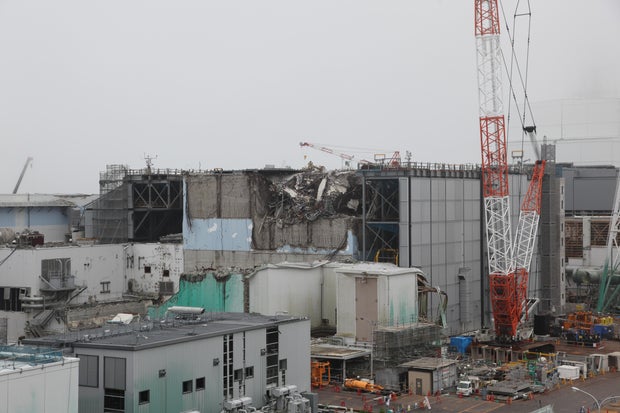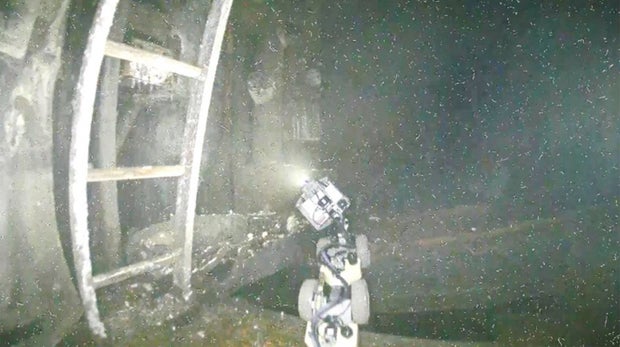CBS News
Challenging next phase of Fukushima nuclear plant cleanup begins with robot set to gather nuclear fuel debris

Tokyo – An extendable robot began a two-week mission Tuesday to retrieve the first sample of melted fuel debris from inside one of three damaged reactors at the Fukushima Daiichi nuclear power plant. Highly radioactive fuel and other materials in the reactors melted when a massive earthquake and tsunami in 2011 damaged the plant’s cooling systems.
The plant’s operator, Tokyo Electric Power Company Holdings, has previously used small robots to examine the inside of the reactors, but Tuesday was to be the first attempt by the robot and its operators to collect a sample of the melted debris. The operation marks the beginning of the most challenging part of the plant’s decades-long decommissioning.
The mission was initially scheduled to begin on Aug. 22 but was suspended when workers noticed that the 5-foot pipes they were using to push the robot into the reactor had been arranged in the wrong order, TEPCO said. The equipment was reassembled in the right order for Tuesday’s attempt, the company said.
Once inside the reactor vessel, the robot, nicknamed “telesco,” is operated remotely from a safer location.
The robot can extend to a length of about 72 feet, including the pipes pushing it from behind, to reach the melted fuel mound, where it will use tongs to collect a fragment measuring less than a tenth of one ounce. It is expected to take about two weeks to obtain the fragment.
An estimated 880 tons of fatally radioactive molten fuel remains inside the three crippled reactors.
Chief Japanese government spokesperson Yoshimasa Hayashi noted that the mission marked the start of the most difficult phase of the Fukushima Daiichi cleanup.
“The government will firmly and responsibly tackle the decommissioning until the very end,” he vowed.
Pallava Bagla/Corbis/Getty
The government and TEPCO have set a 30- to 40-year target for the cleanup, despite criticism that the timescale is unrealistic. No specific plans for the full removal of the melted fuel debris or its storage have been decided.
In March, TEPCO released a dozen images taken by the miniature drones sent deep into a badly damaged reactor at the plant, showing displaced control equipment and misshapen materials, but leaving many questions unanswered about the daunting task of decommissioning the facility. The photos were the first from inside the main structural support called the pedestal in the hardest-hit No. 1 reactor’s primary containment vessel, an area directly under the reactor’s core.
The high-definition color images captured by the drones showed brown objects with various shapes and sizes dangling from various locations in the pedestal. Parts of the control-rod drive mechanism, which controled the nuclear chain reaction inside the reactor, and other equipment attached to the core, were dislodged.
TEPCO via AP
TEPCO officials said they were unable to tell from the images whether the dangling lumps were melted fuel or melted equipment without obtaining other data, such as radiation levels. The drones didn’t carry dosimeters to measure radiation as they had to be lightweight and maneuverable.
The drone cameras could not see the bottom of the reactor core, in part because of the darkness of the containment vessel, officials said.
Officials hope the information from those initial probes and the looming sample mission using the larger robot will help them to develop technologies and other robots to complete the removal of the highly radioactive waste.
CBS News
A Moment With: Viswa Colluru

Watch CBS News
Be the first to know
Get browser notifications for breaking news, live events, and exclusive reporting.
CBS News
A Moment With: Antonio Berga and Carlos Serrano

Watch CBS News
Be the first to know
Get browser notifications for breaking news, live events, and exclusive reporting.
CBS News
Yellowstone hiker burned when she falls into scalding water near Old Faithful, park officials say

Yellowstone National Park, Wyo. — A New Hampshire woman suffered severe burns on her leg after hiking off-trail in Yellowstone National Park and falling into scalding water in a thermal area near the Old Faithful geyser, park officials said.
The 60-year-old woman from Windsor, New Hampshire, along with her husband and their leashed dog were walking off a designated trail near the Mallard Lake Trailhead on Monday afternoon when she broke through a thin crust over the water and suffered second- and third-degree burns to her lower leg, park officials said. Her husband and the dog weren’t injured.
The woman was flown to Eastern Idaho Regional Medical Center in Idaho Falls, Idaho for treatment.
National Park Service / Jacob W. Frank
Park visitors are reminded to stay on boardwalks and trails in hydrothermal areas and exercise extreme caution. The ground in those areas is fragile and thin and there’s scalding water just below the surface, park officials said.
Pets are allowed in limited, developed areas of Yellowstone park but are prohibited on boardwalks, hiking trails, in the backcountry and in thermal areas.
The incident is under investigation. The woman’s name wasn’t made public.
This is the first known thermal injury in Yellowstone in 2024, park officials said in a statement. The park had recorded 3.5 million visitors through August this year.
Hot springs have injured and killed more people in Yellowstone National Park than any other natural feature, the National Park Service said. At least 22 people have died from hot spring-related injuries in and around the 3,471-square-mile national park since 1890, park officials have said.










